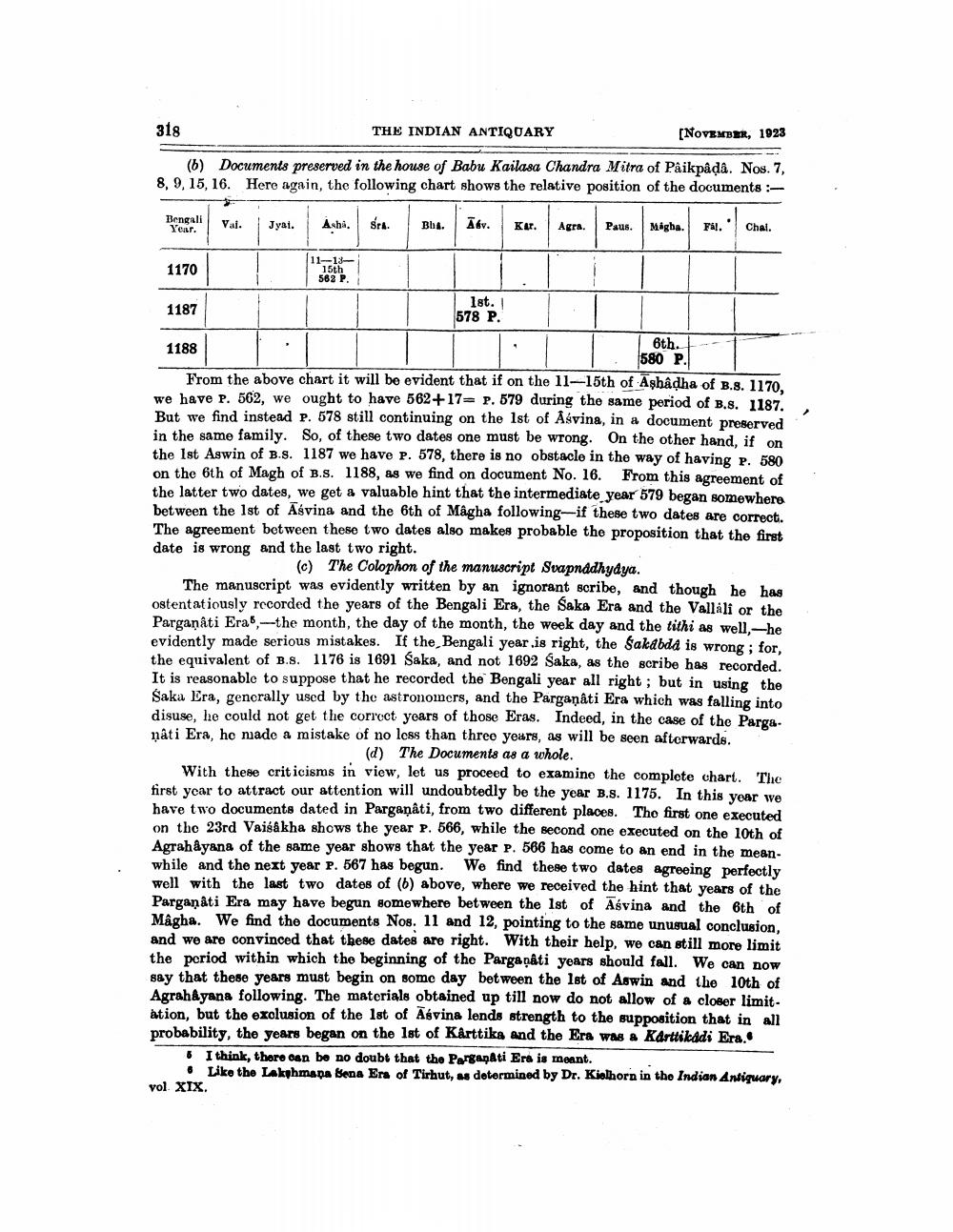________________
318
THE INDIAN ANTIQUARY
[NOVEMBER, 1923
(b) Documents preserved in the house of Babu Kailasa Chandra Mitra of Paikpâdâ. Nos. 7, 8, 9, 15, 16. Here again, the following chart shows the relative position of the documents :
Adv. Kar. Agra. Paus. Magha. Fál. Chai.
Bengali Year.
1170
1187
1188
Vai. Jyai.
Asha.
11-1315th 562 P.
STA.
Bha.
1st. I 578 P.
6th. 580 P.
From the above chart it will be evident that if on the 11-15th of Ashâdha of B.S. 1170, we have P. 562, we ought to have 562+17= P. 579 during the same period of B.S. 1187. But we find instead P. 578 still continuing on the 1st of Aśvina, in a document preserved in the same family. So, of these two dates one must be wrong. On the other hand, if on the 1st Aswin of B.S. 1187 we have P. 578, there is no obstacle in the way of having P. 580 on the 6th of Magh of B.S. 1188, as we find on document No. 16. From this agreement of the latter two dates, we get a valuable hint that the intermediate year 579 began somewhere between the 1st of Aśvina and the 6th of Magha following-if these two dates are correct. The agreement between these two dates also makes probable the proposition that the first date is wrong and the last two right.
(c) The Colophon of the manuscript Svapnadhyaya.
The manuscript was evidently written by an ignorant scribe, and though he has ostentatiously recorded the years of the Bengali Era, the Saka Era and the Vallali or the Parganâti Era, the month, the day of the month, the week day and the tithi as well,-he evidently made serious mistakes. If the Bengali year is right, the Sakabdd is wrong; for, the equivalent of B.S. 1176 is 1691 Saka, and not 1692 Saka, as the scribe has recorded. It is reasonable to suppose that he recorded the Bengali year all right; but in using the Saka Era, generally used by the astronomers, and the Parganâti Era which was falling into disuse, he could not get the correct years of those Eras. Indeed, in the case of the Parga. nâti Era, he made a mistake of no less than three years, as will be seen afterwards.
(d) The Documents as a whole.
With these criticisms in view, let us proceed to examine the complete chart. The first year to attract our attention will undoubtedly be the year B.S. 1175. In this year we have two documents dated in Parganâti, from two different places. The first one executed on the 23rd Vaisakha shows the year P. 566, while the second one executed on the 10th of Agrahayana of the same year shows that the year P. 566 has come to an end in the meanwhile and the next year P. 567 has begun. We find these two dates agreeing perfectly well with the last two dates of (b) above, where we received the hint that years of the Parganâti Era may have begun somewhere between the 1st of Aśvina and the 6th of Mâgha. We find the documents Nos. 11 and 12, pointing to the same unusual conclusion, and we are convinced that these dates are right. With their help, we can still more limit the period within which the beginning of the Parganâti years should fall. We can now say that these years must begin on some day between the 1st of Aswin and the 10th of Agrahayana following. The materials obtained up till now do not allow of a closer limitation, but the exclusion of the 1st of Aśvina lends strength to the supposition that in all probability, the years began on the 1st of Kârttika and the Era was a Karttikadi Era.
5 I think, there can be no doubt that the Parganati Era is meant.
Like the Lakshmana Sena Era of Tirhut, as determined by Dr. Kielhorn in the Indian Antiquary,
vol. XIX.




